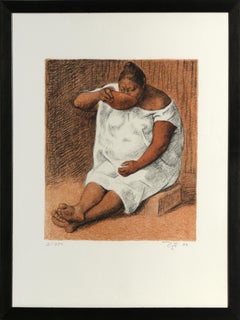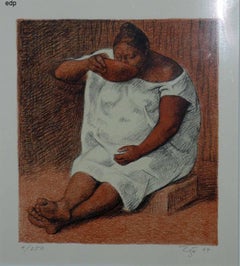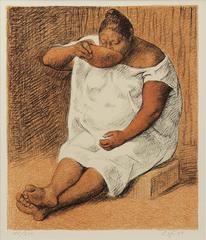Francisco Zuniga Woman Drinking
1980s Expressionist Figurative Prints
Lithograph
1980s Figurative Prints
Lithograph
Recent Sales
1980s Figurative Prints
Lithograph
People Also Browsed
1980s Expressionist Figurative Prints
Lithograph
1980s Expressionist Figurative Prints
Lithograph
Francisco Zúñiga for sale on 1stDibs
Known as one of the most important Expressionist artists to emerge from Latin America, Francisco Zúñiga is remembered for his monumental sculptures, figurative paintings and prints, nude drawings and portraits of Central America’s rural indigenous women.
Born in San José, Costa Rica, in 1912, Zúñiga’s exposure to artistic sculpture began at the age of 13, when he worked with his father, Manuel Maria Zúñiga, carving religious figures for local churches. Spurred by a growing interest in art, Zúñiga attended San José’s School of Fine Arts, where he became influenced by classical, renaissance figurative art. After winning several local awards for his prodigious talent, Zúñiga left San José for Mexico City in 1936.
In Mexico City, he attended La Esmeralda, the painting and sculpture school of the National Institute of Fine Arts. There, Zúñiga studied under sculptor Oliverio Martinez and painter Manuel Rodriguez Lozano.
In 1938, Zúñiga joined the faculty at La Esmeralda, where he taught sculpture and painting until 1970. Meanwhile, during the early 1940s, Zúñiga’s works began to attract the attention of art critics in the United States as well as important collectors. In 1941, the Arts Club of Chicago included him as part of their “Thirteen Mexican Artists” group show. The following year, Alfred Barr, director of the Museum of Modern Art in New York, purchased one of his stone sculptures for MoMA’s permanent collection. Then, in 1943, New York’s Metropolitan Museum of Art acquired two of Zúñiga’s drawings.
Throughout most of his career, Zúñiga limited his subject matter to indigenous peasant women. However, he experimented with working with a variety of materials for his sculptures — bronze, alabaster, plaster, marble and modeling clay — and sought new media to create his art. (He made his first lithograph at age 60.)
Zúñiga won countless accolades in his lifetime. He won international awards for 35 of his public sculptures along with other works, and in 1992, he won Mexico’s highest cultural award, the Premio Nacional de Calidad.
Even after his death in 1998, Zúñiga’s legacy lives on. His sculptures, drawings, paintings and prints are found in museums around the world, including MoMA and the Met in New York, the Museum of Modern Art in Mexico City, the Fogg Museum at Harvard University, the Hirshhorn Museum and Sculpture Garden in Washington, D.C., the Middleheim Museum in Antwerp, Belgium and the Open-Air Museum in Hakone, Japan.
On 1stDibs, discover a range of Francisco Zúñiga prints, drawings and paintings.
Finding the Right Figurative-prints-works-on-paper for You
Bring energy and an array of welcome colors and textures into your space by decorating with figurative fine-art prints and works on paper.
Figurative art stands in contrast to abstract art, which is more expressive than representational. The oldest-known work of figurative art is a figurative painting — specifically, a rock painting of an animal made over 40,000 years ago in Borneo. This remnant of a remote past has long faded, but its depiction of a cattle-like creature in elegant ocher markings endures.
Since then, figurative art has evolved significantly as it continues to represent the world, including a breadth of works on paper, including printmaking. This includes woodcuts, which are a type of relief print with perennial popularity among collectors. The artist carves into a block and applies ink to the raised surface, which is then pressed onto paper. There are also planographic prints, which use metal plates, stones or other flat surfaces as their base. The artist will often draw on the surface with grease crayon and then apply ink to those markings. Lithographs are a common version of planographic prints.
Figurative art printmaking was especially popular during the height of the Pop art movement, and this kind of work can be seen in artist Andy Warhol’s extensive use of photographic silkscreen printing. Everyday objects, logos and scenes were given a unique twist, whether in the style of a comic strip or in the use of neon colors.
Explore an impressive collection of figurative art prints for sale on 1stDibs and read about how to arrange your wall art.


